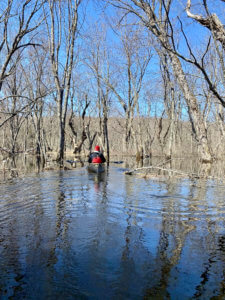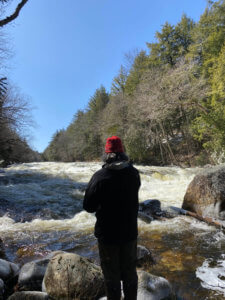 Maybe it’s the backcountry skier in me, but there’s something about weaving in and out of trees that will never get old — and maybe that’s why I always mark the transition from winter to spring with a paddle upstream to Raquette Falls.
Maybe it’s the backcountry skier in me, but there’s something about weaving in and out of trees that will never get old — and maybe that’s why I always mark the transition from winter to spring with a paddle upstream to Raquette Falls.
When people ask me about my favorite paddling trip, I usually take a minute to mull it over just in case something new comes to mind, but without fail I come back to the Raquette River in spring. It offers some of the big things I love in an outdoor adventure:
- Relative quiet. Generally speaking, there’s not much traffic on the Raquette in April and early May. I can’t say whether that’s air and water temperatures acting as a deterrent or if folks are out of town and skipping mud season (I can’t blame them) — either way, my encounters with other paddlers are few and far between, aside from my paddling companion.
- A different perspective. Perhaps the biggest draw for me is the high water levels, which let you meander through the trees and through areas that are inaccessible by boat later in the paddling season. A word of caution, though: It’s easy to lose your way, especially when going downstream — one reason I always bring a paddling buddy.
- Early signs of life. Taken together, the relative quiet and altered perspective offered up by the Raquette in the springtime provide a fairly unique glimpse of wildlife awakening from winter. The lack of motorized traffic early in the season makes it easy to hear birds, beavers and other animals, and the ability to explore more territory means glimpses at flowers and other plants coming back to life.
 Springtime paddling on the Raquette comes with plenty of rewards, but also some risk. Paddlers must be prepared for high water and cold temperatures, which means extra attention to clothing and gear. And I can’t stress this enough: bring a partner. If you do end up capsizing or getting turned around, you’ll be grateful to have a friend to come to your aid. It’s also worth noting that even with less motorized traffic early in the season, the possibility that you’ll run into a Jon boat or some other small craft exists.
Springtime paddling on the Raquette comes with plenty of rewards, but also some risk. Paddlers must be prepared for high water and cold temperatures, which means extra attention to clothing and gear. And I can’t stress this enough: bring a partner. If you do end up capsizing or getting turned around, you’ll be grateful to have a friend to come to your aid. It’s also worth noting that even with less motorized traffic early in the season, the possibility that you’ll run into a Jon boat or some other small craft exists.
The NFCT trip report offers more details on this trip, but in short, I like to start at Axton Landing and paddle all the way to Raquette Falls, where you can stash your boat and check out the falls in springtime — a pretty spectacular sight. (Just be extra careful and don’t wander too close to the riverbanks.) Paddling to the falls and back takes anywhere from four to six hours depending on your skill level and how hard you want to push yourself. In the springtime it’s important to note that the paddle upstream will be tougher because of water levels and quicker current — the upside being that the paddle downstream is a whole lot easier for the same reasons. Of course, you can also turn around whenever you want, and a shorter trip still offers up a great experience.
More than anything else, this paddle to Raquette Falls breaks me out of the post-winter, pre-summer funk I find myself in every spring. The crisp air, bright sun and early signs of life combine to break the mud season blues — I can’t recommend it enough.
To share your favorite springtime paddle on our blog, get in touch with Chris at chris@northernforestcanoetrail.org.